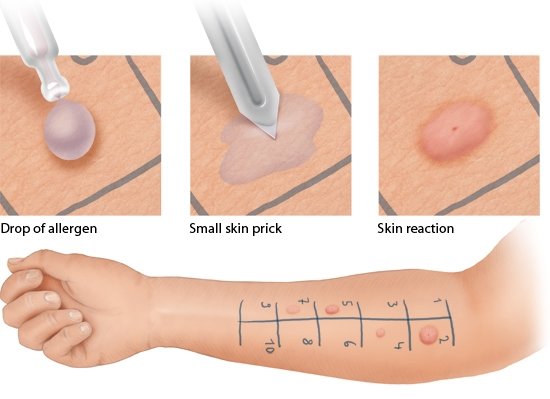How are skin tests done?
Skin prick test
In this test, the doctor puts drops of different watery solutions containing allergens (like pollen or trace amounts of animal hair) on various marked positions on your skin. Your skin is then pricked a little at each site so that the allergens can enter the skin. To test for a food allergy, the food can be pricked first – before pricking your skin.
If you're allergic to the substance, your skin will react: On light-colored skin, the marked site will become red and a small bump (wheal) will appear. Wheals develop on dark skin too, but they're more the color of the surrounding skin or a bit lighter. The skin prick test is mainly used to detect allergies that trigger an immediate reaction when they make contact with the skin – such as hay fever or some food allergies.
Intradermal test
The procedure here is similar to that of the skin prick test, but the allergen solution is injected into the skin (intradermal injection) instead. Intradermal tests can also detect weaker allergic reactions.
Because the injections make the test somewhat unpleasant and the injections can also trigger stronger allergic reactions, this test is generally only used if a skin prick test did not show enough of a response.
Skin scratch / scrape test
A skin scratch test can be used if the results of the skin prick test are not clear. This involves removing a small area of skin and then "rubbing" the allergen over the skin. That way, the substances reach deeper layers of tissue than possible in the skin prick test, with the aim of provoking a stronger reaction. The skin scrape test is similar, but only the outermost layer of skin is removed.
In these tests, it’s not possible to regulate exactly how much of the allergen enters the skin and tissue. They are also more likely to cause non-allergic skin irritation than the skin prick test is. So this test is considered to be less reliable.
Applying the allergen externally
If your doctor thinks that your skin will react very strongly, the substance can simply be rubbed onto your forearm without breaking your skin. Compared to the skin prick test, it will take a little longer for the results to appear: If you have an allergy, a reaction will be visible after about 20 minutes. Light skin will then become red with swollen bumps (wheals). Wheals develop on dark skin, too, but the affected skin is darker in color rather than red.
Patch test
This test is used if you are thought to have an allergy where the symptoms only become apparent one half to three days after contact with the allergen. The triggers are often single substances found in:
- Medications such as local anesthetics (lidocaine, tetracaine)
- Cosmetics (preservatives and fragrances, or essential oils)
- Jewelry (nickel or cobalt)
- Gloves or condoms (latex)
A patch containing the suspected allergens is put on your back and left on for one full day. If there is no reaction after it is taken off, your skin is checked again after another 24 hours, and sometimes again three days after removing the patch. If you have a contact allergy, your skin will react in a similar way to when it's inflamed (contact dermatitis): It will become swollen and itchy. Light-colored skin usually turns red as well. This is less common and less noticeable in dark skin. Dark skin is more likely to become thicker and rougher in the affected area. Small bumps and dark spots may develop too.

